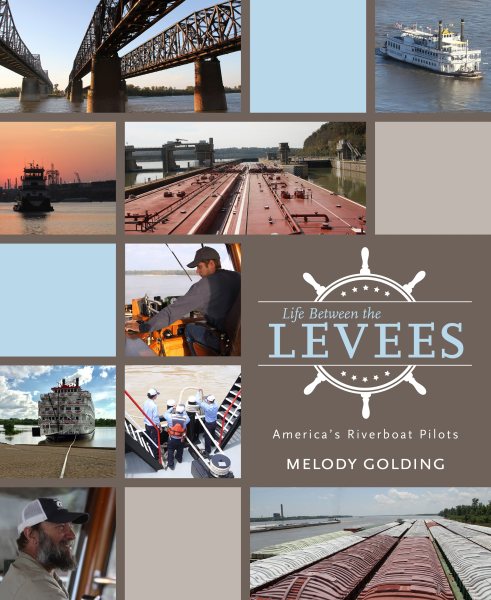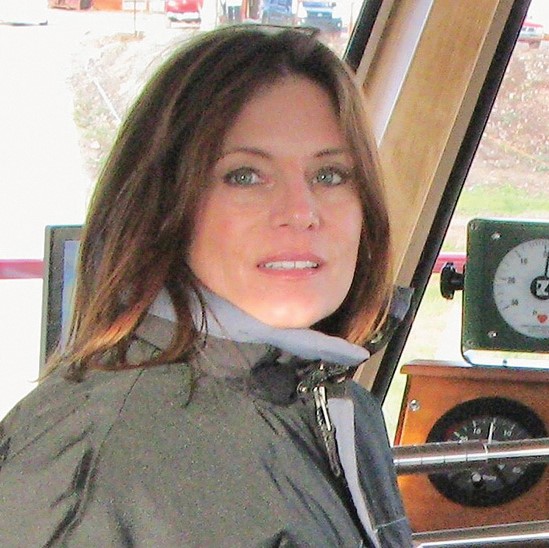Interview by Jana Hoops. Special to the Clarion-Ledger Sunday print edition (October 13)
Vicksburg’s Melody Golding spent 10 years collecting stories from riverboat pilots who shared personal tales of their careers spent on the water, spanning a 70-year period.
 The resulting book from this author, photographer and artist is Life Between the Levees: America’s Riverboat Pilots (University Press of Mississippi). The volume is filled with drama, suspense and a sense of nostalgia as it chronicles the real-life adventures of men and women who have devoted their lives to the “brown water.”
The resulting book from this author, photographer and artist is Life Between the Levees: America’s Riverboat Pilots (University Press of Mississippi). The volume is filled with drama, suspense and a sense of nostalgia as it chronicles the real-life adventures of men and women who have devoted their lives to the “brown water.”
Golding proudly acknowledges that she comes from a riverboat family, thanks to her husband’s 45-year-plus career in the riverboat and barge business. She also points out the incredible impact that riverboats contribute to the nation’s economy.
Her work has been featured at the Smithsonian Institute, the Department of Homeland Security, the National Museum of Women in the Arts in Washington, D.C., and in numerous universities and museums. Her previous books are Katarina: Mississippi Women Remember and Panther Tract: Wild Boar Hunting in the Mississippi Delta.
The Seamen’s Church Institute, a non-profit agency founded in 1834 and affiliated with the Episcopal Church, serves mariners through pastoral care and education. Golding has donated the royalties from the sale of this book to The Seamen’s Church Institute to help further their mission for mariners.
Tell me about your personal connection to the riverboat industry.
Our family has been in the river industry for decades. We have a riverboat and barge line that operates on our inland waterways. We are river people.
Life Between the Levees includes 101 stories shared by as many riverboat pilots who were born more than seven decades apart–from 1915 to 1987. You have said that putting this book together took almost 10 years. Explain the process that required such an extraordinary effort.

Melody Golding
The process of creating this book about pilots’ life on the river involved quite a bit of travel and an extensive amount of time. To interview my pilots, my journeys took me to many cities and ports, from Houston, New Orleans, of course Vicksburg, where I live, to Memphis, Paducah, and Wood River, Ill., just to name a few. I climbed on and off boats and carried my backpack of photographic and recording equipment as well as my Coast Guard regulation lifejacket and my TWIC card (Transportation Workers Identification Card) and I met them on land as well. I recorded the stories, which are first person reflections, then transcribed and presented them as they were told to me.
The book traces the progression of the riverboat industry through a time span that took navigational tools from lanterns placed on the riverbanks to today’s GPS, sonar, Satellite Compass and electronic charting software–but were there also elements of river life that the pilots indicated have pretty much remained the same.
One of the aspects of working out on the river that has remained the same throughout the years would be the “call of the river” that so many mariners experience. There is an old saying on the river that if “you wear out a pair of boots on the river you will stay on the river forever.” Many also say that brown water runs in their veins.
One of my pilots who is also a musician wrote a song about the river and some of the lyrics go, “I hate her when I’m with her and I miss her when I’m gone.” The pilots always reflect movingly on the time spent away from home because of their career, a universal reality for all mariners.
Another aspect that hasn’t changed on the river, and that has remained the same, is that there is no automatic pilot. The pilots have to steer the boat and know where they are.
You state in the book’s introduction that in today’s world, “the river is virtually an unknown territory to those who live and work on land.” Please explain how this is true, and the impact the industry makes on the U.S. economy.
The river is virtually an unknown territory to those who live and work on land largely because it is inaccessible to most people. Streets and railroads run through every town, but the river is bordered by levees and battures (the land between a low-stage river and the levees) and when travelling on the river one can go hundreds of miles without seeing any signs of life. It is a territory that is grand and vast.
The waterways and ports in the Mississippi corridor move billions of dollars of products throughout the U.S. and foreign markets. Inland and intercoastal waterways directly serve 38 states throughout the nation’s heartland as well as the states on the Atlantic seaboard, the Gulf Coast and the Pacific Northwest. The inland waterways of the United States include more than 25,000 miles of navigable waters.
The economic impact is evident as the majority of the grain that is exported comes down the river to the gulf. Over 30 percent of petroleum and chemicals moved in the U.S. today is moved on our inland waterways; and most coal and aggregates are moved by barge.
The first edition of Life Between the Levees sold out quickly. Why do you think this book has been so popular, and who should read it?
I am so very humbled by the interest in Life Between the Levees. I believe it is popular because there isn’t another book “out there” that is like it. This book is full of real-life drama, suspense and a way of life that most people otherwise would have no knowledge of. It is a fun read and can either be read “front to back” or picked up and read where the book falls open.
The photographs tell their own story if one just cares to visually experience the river. Anyone who has an interest in our inland waterways system will enjoy this book. The stories here are told by real river legends. They are the “real deal.”


Comments are closed.